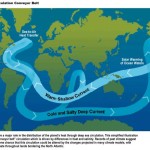Typically turbulence mixes seawater and the things in it. Turbulence takes isolated patches of increased salt, heat, sediment, even plankton, and spreads them out so they are uniformly distributed in space. But researchers have found, contrary to previous ideas, when phytoplankton have the ability to self-propel, they don’t have to disperse. Instead, turbulence can cause motile phytoplankton to aggregate and form patches! And it is this ‘unmixing’ may explains how phytoplankton concentrations become patchy in the ocean at really tiny sub-metre scales.

How exactly are phytoplankton ‘unmixed’? In other words, if I am a motile cell in a big turbulent sea, how should me and my buddies swim so that we can meet up and have these patchy phytoplankton parties?

First of all, don’t be dead. No seriously, dead phytoplankton in both the lab experiment and the turbulence model did not make patches. Only those that are alive and can move themselves in some way formed patches.
Second, you need to swim fast. If you swim faster than the flows in all the tiny vortices created by turbulence, you can swim to the center or edges of these eddies, meet up with your bros and rage on! But while you need to be quick, you don’t need to be the Michael Phelps of the microscopic world. The authors found that you only need to swim faster than the smallest turbulent eddies, rather than the largest and fastest eddies in a turbulent patch as previously thought.
Lastly, you also need to be swimming to the party in a particular state. Humans, when headed to a party, are typically in one of three party states: stone-cold-sober, happily-tipsy, or drunk-as-a-skunk (no phytoplankton were intentionally inebriated in this study). If your group of phytoplankton are in the stone-cold-sober state, you will be traveling in very straight lines upwards and won’t be able to find each other. NO PARTY FOR YOU. If your group of plankton are in the drunk-as-a-skunk state, you will all be wandering all over the place tumbling end over end in any random direction and also won’t be able to find each other. NO PARTY FOR YOU EITHER. But those plankter that are in the somewhat tipsy state, their path isn’t too straight and it isn’t to random which maximizes their ability to find each other. PARTY FOR YOU!! Whether phytoplankton move in a straight line or a random line is determined by their ability to stabilize their torque in turbulent shear. Luckily, the type of conditions that cause phytoplankton to be in the state of intermediate stability are readily found in the ocean.
But why patch? During periods of sexual reproduction, it is likely advantageous to have high densities of phytoplankton. A phytoplankton orgy if you will. On the other hand, it could also be bad to patch. Bad because you have to compete for nutrients (like the last beer at a party), or even make you an easy target for zooplankton predation. Hungry zooplankton have been known to hover in centimeter scale prey patches, gorging on hapless phytoplankton.
But the authors also discuss an intriguing aspect of this ‘unmixing’ due to motility. What if the plankton themselves determine their density distribution? Theoretically, a phytoplankter could choose to change how fast it swims or how much it tumbles, making it more or less likely to aggregate. Therefore if it is to their advantage, phytoplankton can cause themselves to either spread out or form patches! To patch or not to patch, that is the question. In the sprit of maritime revelry, I am going to assume they chose to patch intentionally.
REFERENCE:
William M. Durham, Eric Climent, Michael Barry, Filippo De Lillo, Guido Boffetta, Massimo Cencini, Roman Stocker. Turbulence drives microscale patches of motile phytoplankton. Nature Communications, 2013; 4 DOI:10.1038/ncomms3148
Share the post "Wanna throw a phytoplankton party? Then call in turbulence to help round up your buddies!"






Nice article!! Now i want my phytoplankton party!! lol